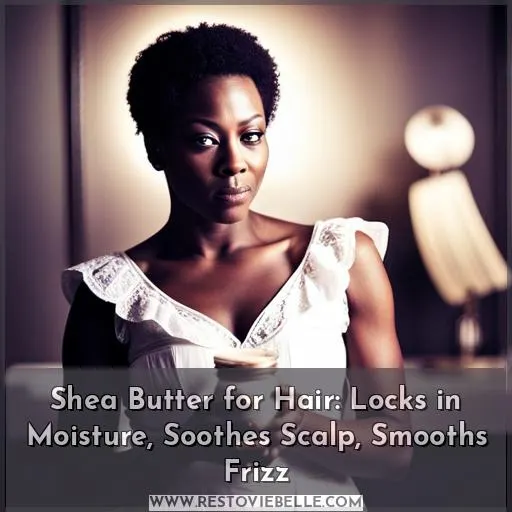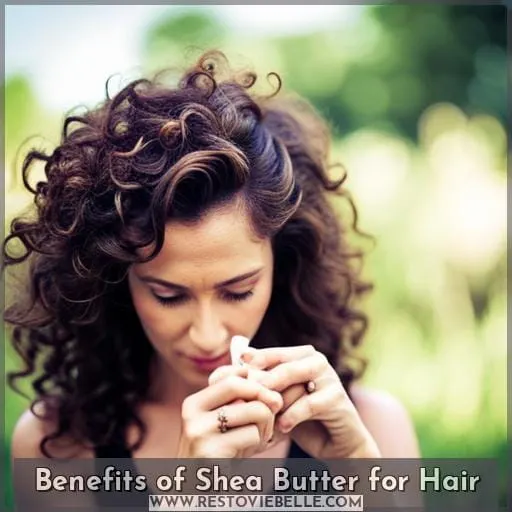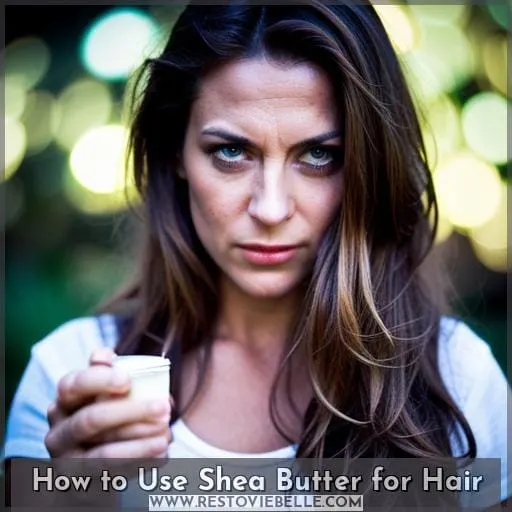This site is supported by our readers. We may earn a commission, at no cost to you, if you purchase through links.
 Unlock the secret to luscious locks with shea butter! This natural ingredient is a game-changer for your hair, locking in moisture, soothing your scalp, and smoothing away frizz.
Unlock the secret to luscious locks with shea butter! This natural ingredient is a game-changer for your hair, locking in moisture, soothing your scalp, and smoothing away frizz.
Say goodbye to dryness and hello to healthy, vibrant hair that shines with confidence.
Discover the power of this wonder ingredient and give your tresses the TLC they deserve.
Table Of Contents
Key Takeaways
- Locks in moisture
- Protects from UV damage
- Soothes irritated scalp
- Protects against heat styling
Benefits of Shea Butter for Hair
Shea butter is an excellent choice for hair care because it offers a range of benefits.
It effectively locks in moisture, preventing dryness and frizz.
Shea butter also provides protection from UV damage, soothes irritated scalps, and acts as a shield against heat styling tools.
Locks in Moisture
Locks in Moisture, Soothes Scalp, Smooths Frizz:
One key benefit of shea butter for hair is that it locks in moisture. This helps with dry hair and prevents split ends by:
- Retaining natural oils
- Sealing in hydration
- Protecting color-treated strands
- Reducing frizz for improved shine.
Shea butter moisturizes hair and scalp.
Protects From UV Damage
You’ll shield your hair and scalp from UV damage by working shea butter through your locks.
The emollients in shea butter create a protective barrier that protects from uv rays. This reduces hair breakage from sun exposure, prevents sun damage, and strengthens hair over time.
Shea also improves hair elasticity for less breakage.
With its natural sun protection, shea butter is an ideal ingredient for hair care formulas seeking to prevent split ends.
Soothes Irritated Scalp
Your scalp’s irritation calms when you apply shea butter’s anti-inflammatory properties.
- Reduces inflammation and scalp irritation
- Prevents dandruff and hair loss
- Promotes hair regrowth
- Softens and improves hair texture
- Soothes and moisturizes dry scalp
Protects Against Heat Styling
Additionally, applying shea butter before heat styling protects your hair and scalp from damage.
The fatty acids lock in moisture, form a protective barrier, and prevent frizz and flyaways when using hot tools.
Shea butter’s emollients improve shine, soften hair, and reduce split ends from heat exposure.
Use a small amount, melting between palms before distributing from roots to ends for optimal protection.
Smoothes Frizz and Flyaways
To achieve smoother, more manageable hair, shea butter works wonders in taming frizz and flyaways.
Its fatty acids lock in moisture to soften strands, prevent dryness, and reduce breakage that causes frizz.
Shea butter also coats the hair shaft to smooth the cuticle and reflect light for extra shine.
Using shea butter regularly helps maintain softer, more defined curls and waves while preventing split ends that exacerbate frizz.
How to Use Shea Butter for Hair
When using shea butter for your hair, start by applying a small amount, melting it first between your palms.
You can also mix it with other natural oils, like coconut or olive, for an extra moisture boost; if you have fine hair, mix just a tiny bit into your oil to soak up benefits without weighing hair down.
Follow tips like doing a patch test and choosing raw, unrefined shea butter to get the most benefits.
Applying a Small Amount
To apply shea butter to your hair, start by:
-Massaging a small amount into your hair and scalp.
-Melting the shea butter between your palms will make it easier to spread evenly.
For best results, apply the shea butter to:
-Damp hair after showering.
-Use it as a leave-in conditioner.
If you want a deep conditioning treatment, leave the shea butter on for:
-At least 30 minutes or overnight.
-Rinse out with warm water and shampooing.
Shea butter is suitable for all hair types, including fine hair, as it’s lightweight and has anti-inflammatory properties that can benefit the scalp.
Mixing With Other Oils
You’re mixing shea butter with other natural oils for an extra moisture-boosting treatment.
Lightweight oils like jojoba or grapeseed help shear the thick shea butter down for easier application.
Thicker oils like olive, almond, and avocado pack an extra hydration punch.
For essential oils, use gentle options like lavender, rosemary, or ylang ylang in DIY hair masks.
Tips for Fine Hair
Often, when using shea butter for fine hair, mix just a tiny amount with other oils to soak up the benefits without weighing your hair down.
| Amount | Tip |
|---|---|
| Pea-sized | Work into ends to avoid build-up |
| Rice-sized | Use as leave-in for lightweight moisture |
| Pinhead | Start with small amount and increase gradually |
Use shea butter sparingly on fine hair, starting with a very small amount worked into the ends. Avoid leaving it on the roots to prevent excess build-up. Try using it as a leave-in conditioner for lightweight moisture.
Tips for Buying Good Quality Shea Butter
When buying shea butter for hair, it’s important to choose a raw or unrefined shea butter in its natural state.
You should also do a patch test on your skin before applying shea butter to your scalp to make sure that you aren’t allergic to it.
Choosing Raw or Unrefined Shea Butter
When buying shea butter for your hair, choose a raw or unrefined product in its natural state to ensure you’re getting the most benefits.
Unrefined shea butter retains its natural vitamins, minerals, and moisture that nourish hair follicles and soothe the scalp.
Seek out raw, unfiltered shea butter sold in its natural state. Store in an airtight container away from light and heat to preserve integrity.
Massage a small amount into damp hair and style as usual so your locks reap the hydrating and protecting perks.
Patch Testing for Allergies
Although choosing raw or unrefined shea butter ensures you’re getting the most benefits, you should also do a patch test on your skin before applying shea butter to your scalp.
Carefully apply a dab to your inner elbow, behind your ear, or wrist and wait 24 hours. If any redness or itching develops, avoid using shea butter, as you may be allergic.
Those with oily hair should use sparingly, while shea butter can feel heavy on thin strands. Still, when selecting quality shea butter and patch testing with no reaction, it makes an ideal leave-in conditioner.
Frequently Asked Questions (FAQs)
Does shea butter help with dandruff?
Yes, shea butter can help reduce dandruff.
Its fatty acids moisturize and soothe the scalp, while its anti-inflammatory properties calm irritation that causes flakes.
Gently massage it into your scalp and let it sit before rinsing.
It may take regular applications to see improvement.
Can I use shea butter if I have fine or oily hair?
You can, but use it sparingly.
Focus on the mid-lengths and ends rather than roots. Shea is moisturizing so only use a tiny bit to avoid weighing down fine or oily hair.
Melt it between palms before gently smoothing onto damp hair post-shower.
How often should I use shea butter treatments on my hair?
Apply a shea butter hair treatment once or twice a week. Using it more often may weigh down fine hair.
For deeper conditioning, cover hair with a shower cap after applying shea butter and leave on for 30-60 minutes before shampooing as usual.
Adjust frequency as needed based on your hair’s moisture levels.
Does raw shea butter go bad or expire?
Raw shea butter doesn’t expire, but it can go bad if not stored properly.
It’s best to keep it in a cool, dark place and tightly sealed to maintain its freshness and effectiveness for longer periods of time.
What’s the difference between refined and unrefined shea butter for hair?
Go for unrefined shea butter.
Refining removes its natural vitamins and fatty acids that nourish hair.
Unrefined retains these through minimal processing, sealing in more moisture and shine without chemicals.
Conclusion
To sum it up, shea butter is a fantastic natural ingredient that can work wonders for your hair. It locks in moisture, soothes your scalp, and smooths away frizz, leaving you with healthy and vibrant locks.
Remember to apply a small amount or mix it with other oils for best results.
When purchasing shea butter, opt for raw or unrefined options and always do a patch test to avoid any allergies.
Say goodbye to dryness and hello to luscious locks with shea butter!








